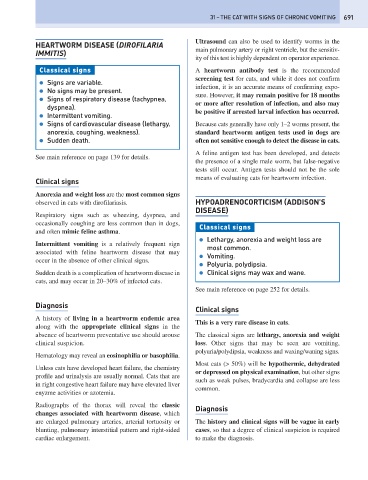Page 699 - Problem-Based Feline Medicine
P. 699
31 – THE CAT WITH SIGNS OF CHRONIC VOMITING 691
Ultrasound can also be used to identify worms in the
HEARTWORM DISEASE (DIROFILARIA
IMMITIS) main pulmonary artery or right ventricle, but the sensitiv-
ity of this test is highly dependent on operator experience.
Classical signs A heartworm antibody test is the recommended
screening test for cats, and while it does not confirm
● Signs are variable.
infection, it is an accurate means of confirming expo-
● No signs may be present.
sure. However, it may remain positive for 18 months
● Signs of respiratory disease (tachypnea,
or more after resolution of infection, and also may
dyspnea).
be positive if arrested larval infection has occurred.
● Intermittent vomiting.
● Signs of cardiovascular disease (lethargy, Because cats generally have only 1–2 worms present, the
anorexia, coughing, weakness). standard heartworm antigen tests used in dogs are
● Sudden death. often not sensitive enough to detect the disease in cats.
A feline antigen test has been developed, and detects
See main reference on page 139 for details.
the presence of a single male worm, but false-negative
tests still occur. Antigen tests should not be the sole
means of evaluating cats for heartworm infection.
Clinical signs
Anorexia and weight loss are the most common signs
observed in cats with dirofilariasis. HYPOADRENOCORTICISM (ADDISON’S
DISEASE)
Respiratory signs such as wheezing, dyspnea, and
occasionally coughing are less common than in dogs,
Classical signs
and often mimic feline asthma.
● Lethargy, anorexia and weight loss are
Intermittent vomiting is a relatively frequent sign
most common.
associated with feline heartworm disease that may
● Vomiting.
occur in the absence of other clinical signs.
● Polyuria, polydipsia.
Sudden death is a complication of heartworm disease in ● Clinical signs may wax and wane.
cats, and may occur in 20–30% of infected cats.
See main reference on page 252 for details.
Diagnosis
Clinical signs
A history of living in a heartworm endemic area
This is a very rare disease in cats.
along with the appropriate clinical signs in the
absence of heartworm preventative use should arouse The classical signs are lethargy, anorexia and weight
clinical suspicion. loss. Other signs that may be seen are vomiting,
polyuria/polydipsia, weakness and waxing/waning signs.
Hematology may reveal an eosinophilia or basophilia.
Most cats (> 50%) will be hypothermic, dehydrated
Unless cats have developed heart failure, the chemistry
or depressed on physical examination, but other signs
profile and urinalysis are usually normal. Cats that are
such as weak pulses, bradycardia and collapse are less
in right congestive heart failure may have elevated liver
common.
enyzme activities or azotemia.
Radiographs of the thorax will reveal the classic
Diagnosis
changes associated with heartworm disease, which
are enlarged pulmonary arteries, arterial tortuosity or The history and clinical signs will be vague in early
blunting, pulmonary interstitial pattern and right-sided cases, so that a degree of clinical suspicion is required
cardiac enlargement. to make the diagnosis.

